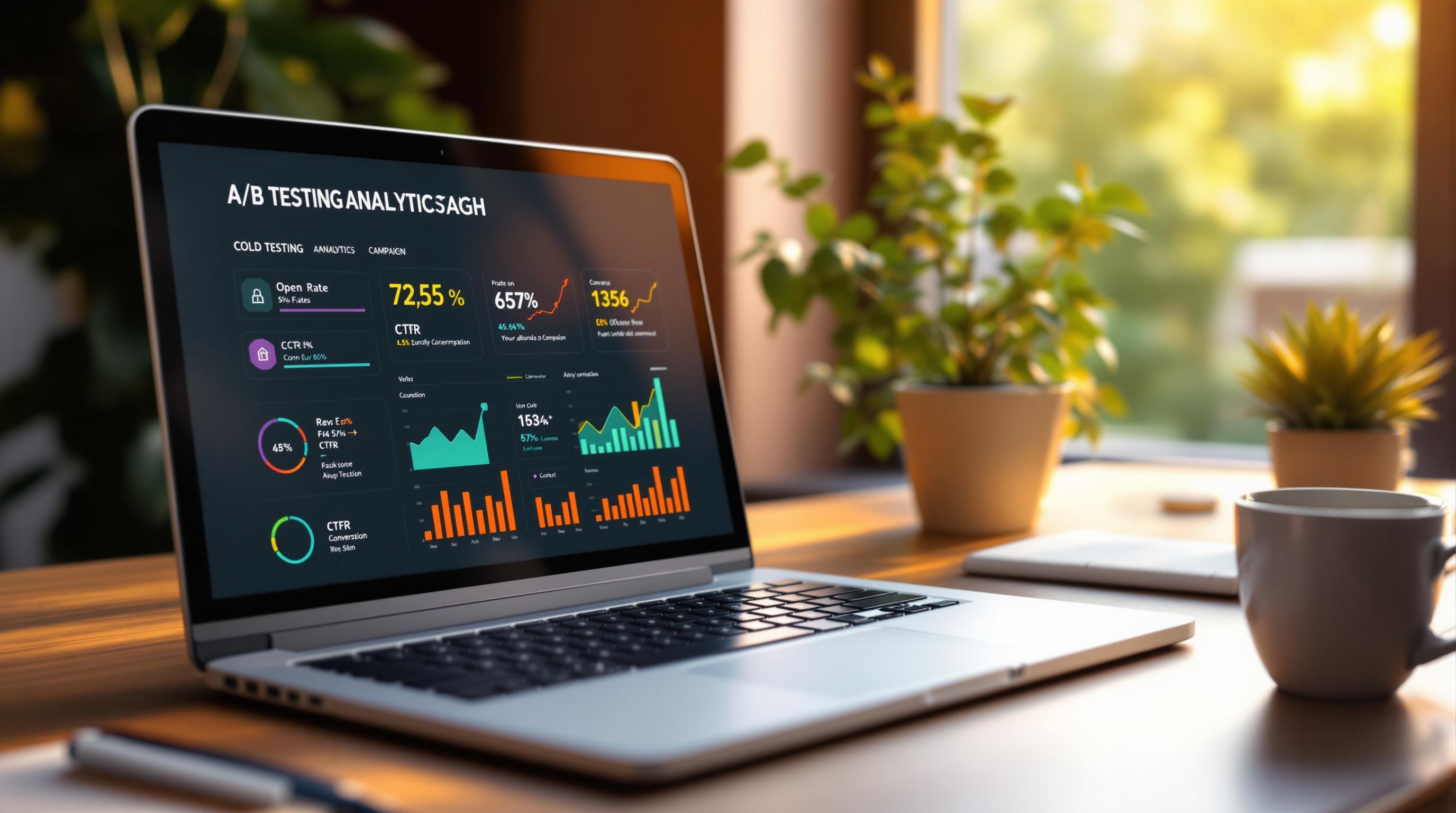CRM systems can transform your sales funnel by improving lead quality, reducing costs, and increasing customer retention. Businesses using CRM insights report higher conversion rates, better lead targeting, and stronger customer relationships. Here's how:
- Track Key Metrics: CRM tools analyze metrics like MQL to SQL conversion, Customer Acquisition Cost (CAC), and Lifetime Value (LTV) to identify bottlenecks and boost efficiency.
- Focus on High-Potential Leads: Tools like automated lead scoring prioritize leads based on engagement and behavior, increasing sales-ready leads by up to 50%.
- Personalized Communication: CRM data enables tailored outreach, improving engagement and customer satisfaction.
- Automate Lead Nurturing: Automation ensures timely follow-ups, helping businesses scale while cutting lead generation costs by 33%.
- Retain Customers: CRM insights help track customer behavior, predict churn, and boost retention rates, which can increase profits by up to 95%.
CRM and Sales Funnel Basics
CRM Fundamentals
A Customer Relationship Management (CRM) system acts as a central hub for organizing customer data and managing interactions throughout the sales journey. These platforms bring together a variety of customer details, such as contact information, purchase history, and behavioral patterns [1].
Take Hurst Review, for instance. By streamlining its CRM platform, the company reduced marketing expenses by 20% through more targeted campaigns [2]. With all customer data in one place, businesses can monitor essential metrics and refine their sales funnels effectively.
Main Sales Funnel Metrics
CRM systems help track critical metrics that reveal how well a sales funnel is performing:
| Metric Category | Key Measurements | Purpose |
|---|---|---|
| Lead Quality | MQL to SQL Conversion | Evaluates how effectively leads are being qualified |
| Financial Impact | Customer Acquisition Cost (CAC) | Tracks the cost-efficiency of acquiring customers |
| Customer Value | Lifetime Value (LTV) | Gauges the overall value of long-term relationships |
For B2B companies, sales cycles often range from 3 months to a year [3]. A well-optimized funnel aims to increase lifetime value while keeping acquisition costs low. Using these metrics, businesses can pinpoint areas for improvement and boost sales outcomes.
CRM Data Impact on Sales
Analyzing CRM data has directly improved sales results for many companies. For example, Brex and Gorgias reported a 40% jump in booked demos and a 55% increase in qualified deals by utilizing CRM insights [4].
"When you analyze CRM data, you can make better business decisions." - NASP Author [2]
CRM systems track interactions across various touchpoints, helping sales teams identify weak spots and fine-tune their strategies at different funnel stages. By focusing on the most relevant KPIs, companies can significantly improve their sales performance.
Using CRM Data to Increase Conversions
Lead Quality Assessment
Focusing on the right leads can make a huge difference. Companies that prioritize nurturing generate 50% more sales-ready leads while cutting costs by 33% [1]. Here's a quick breakdown of the key indicators to evaluate lead quality:
| Quality Indicator | Scoring Criteria | Impact on Conversion |
|---|---|---|
| BANT Framework | Budget, Authority, Need, Timeline | Identifies decision-ready leads |
| Engagement Level | Website visits, Content downloads, Email opens | Tracks interest level |
| Behavioral Signals | Pricing page visits, Demo requests | Shows purchase intent |
Tools like Nutshell's lead confidence feature use automated scoring to help sales teams zero in on leads that align with their ideal customer profile. Once you've identified these high-potential leads, the next step is to engage them with targeted communication.
Data-Driven Lead Communication
CRM data is your secret weapon for personalizing outreach. By analyzing past interactions, content preferences, and response patterns, you can craft messages that truly connect with prospects.
"Your CRM is a powerful lead nurturing machine. Learn how to leverage it to narrow down your audience to the leads that matter and grow your business." - Mihaela Chiurtu, Marketing Content Writer [4]
Scaling these personalized efforts, however, requires automation to maintain consistent and effective engagement.
Lead Nurturing Automation
Automation takes personalized communication to the next level by making it scalable and reliable throughout the sales process. In fact, 91% of marketers who use automation say it’s "very important" to their success [5].
SureTriggers is a great example of automation in action. It assigns points for valuable actions like high-priority page visits, sends personalized emails, and automates lead grading to ensure timely follow-ups. This keeps engagement consistent and tailored.
And the payoff? According to Nucleus Research, every dollar spent on CRM can yield up to $8.71 in returns [4]. That's a clear case for making automation and CRM tools a priority.
CRM Methods for Customer Retention
Customer Behavior Analysis
Keeping current customers happy is just as important as gaining new ones. CRM systems help by analyzing customer interactions across various channels, spotting trends that indicate satisfaction or potential churn. Did you know that 71% of customers expect personalized experiences when they shop? That’s a huge opportunity for businesses to stand out.
Take a look at how customer retention rates vary across industries:
| Industry | Average Retention Rate (%) |
|---|---|
| Professional Services | 80 |
| Insurance & Transportation | 83 |
| Healthcare & Software | 77 |
| Manufacturing & Retail | 67 |
| Hospitality & Travel | 55 |
Customer Retention Programs
Boosting customer retention by just 5% can increase profits by 25% to 95%. Many businesses use CRM data to create programs that keep customers coming back.
A great example is HubSpot, which offers a library of free training courses. These courses not only help users master the platform but also build their professional skills. This added value makes customers more likely to stick around.
Customer Value Tracking
CRM systems make it easy to track Customer Lifetime Value (CLV). For example, a customer paying $50/month for two years has a CLV of $1,200. Knowing this helps businesses focus on their most valuable customers.
Here’s how to make the most of your CRM for customer value:
- Send automated satisfaction surveys to address problems before customers leave.
- Personalize communication by using insights from their interaction history.
- Monitor engagement metrics to catch early signs of dissatisfaction.
Retaining customers costs 3-6 times less than acquiring new ones and can contribute up to 65% of revenue. By understanding customer value, businesses can fine-tune their marketing and sales strategies to drive growth.
sbb-itb-8abf799
Connecting CRM with Marketing Tools
Modern CRM systems play a central role in bringing sales and marketing teams together. When integrated with marketing tools, they create a seamless system that boosts funnel performance and increases conversion rates.
Sales and Marketing Coordination
A shared CRM and unified customer data are key to aligning sales and marketing. Companies with synchronized teams report 36% higher customer retention rates and generate more revenue. This setup allows teams to make smarter decisions about lead quality, content strategies, and campaign adjustments based on real customer interactions and engagement data.
With both teams working from the same insights, businesses can refine their campaigns and improve ROI.
Improving Marketing Results
CRM systems offer valuable insights for evaluating and refining marketing efforts. By analyzing CRM data, businesses can pinpoint which channels are bringing in the best leads. On average, B2B industries see lead conversion rates between 1-5%, while B2C businesses experience rates of 5-10% [2].
"Integrating your CRM software with marketing automation helps improve lead conversion rate because it helps deliver focused ads. Relevant ads draw in leads that convert at a much higher rate than generic ads." - Melanie Musson, TopQuoteLifeInsurance.com [4]
Using CRM data, companies can track where leads come from, review customer journey milestones, measure ROI across platforms, and fine-tune strategies in real time.
Email Extractor Tool - Streamline Lead Management with AI

AI tools can take CRM performance to the next level by automating lead generation. The Email Extractor Tool works with CRM platforms to simplify lead collection and management. Its ability to process high volumes makes it ideal for large campaigns, while automation ensures a steady stream of leads flows directly into your CRM system.
Steps to Improve Sales Funnel Results
Improving sales funnel performance takes more than just integrating CRM and marketing tools. It’s about leveraging data, analyzing trends, and testing strategies to make informed adjustments.
CRM Dashboard Setup
Set up dashboards to focus on key metrics like lead conversion rates, sales velocity, and retention rates - all aligned with your sales objectives [1][3]. These dashboards help you track lead progress through each funnel stage and pinpoint where prospects drop off. For example, Salesforce users can create pipeline visualizations showing conversion rates between stages, making it easier to identify problem areas. Once your dashboard is ready, use it to evaluate performance and extract actionable insights.
Sales Funnel Analysis
Dive into each stage of your funnel to analyze conversion rates and locate bottlenecks. Break down leads by attributes like source, industry, or location to uncover trends and adjust your strategy accordingly. This segmented approach can boost lead conversion rates by 2% to 10%, depending on the industry [2][4]. These insights allow you to fine-tune your approach through systematic testing and iteration.
Testing and Refinement Process
Refine your sales tactics using A/B testing and CRM data [5]. Monitor engagement metrics and conversion rates to see how well your lead nurturing efforts are working. Data-driven lead nurturing strategies have been shown to increase conversion rates by as much as 15% [2].
Keep your CRM data accurate with regular updates and cleansing. Implement lead scoring to focus on high-potential prospects, and adjust your methods based on what the data reveals about successful conversions [2]. These steps ensure your sales funnel remains efficient and effective.
Conclusion
Improving sales funnel metrics using CRM insights plays a key role in driving business growth. Combining tools like Email Extractor Tool with CRM systems can boost lead generation and outreach efforts. For instance, email marketing delivers an average return of $36 for every dollar spent, while CRM systems generate $5.60 per dollar invested [4].
Building effective CRM dashboards and using structured analysis can help businesses make smarter, data-driven decisions. Tools like the Email Extractor Tool work seamlessly with CRM insights to target leads more effectively.
To get the best results, focus on keeping CRM data accurate, updating your sales pipeline consistently, and tracking performance metrics with real-time dashboards. These practices help ensure your sales funnel stays efficient and aligned with your business goals.



